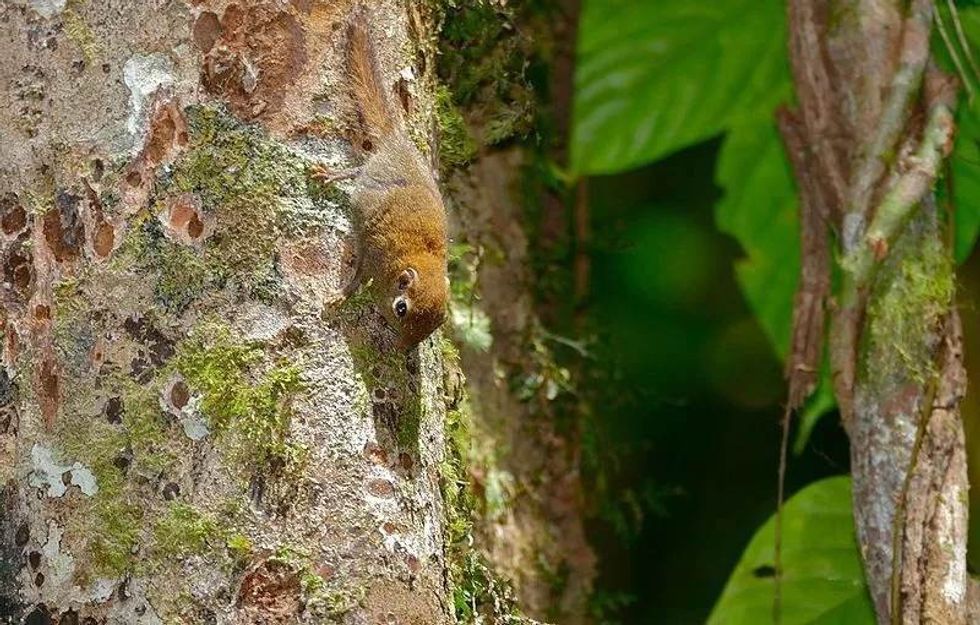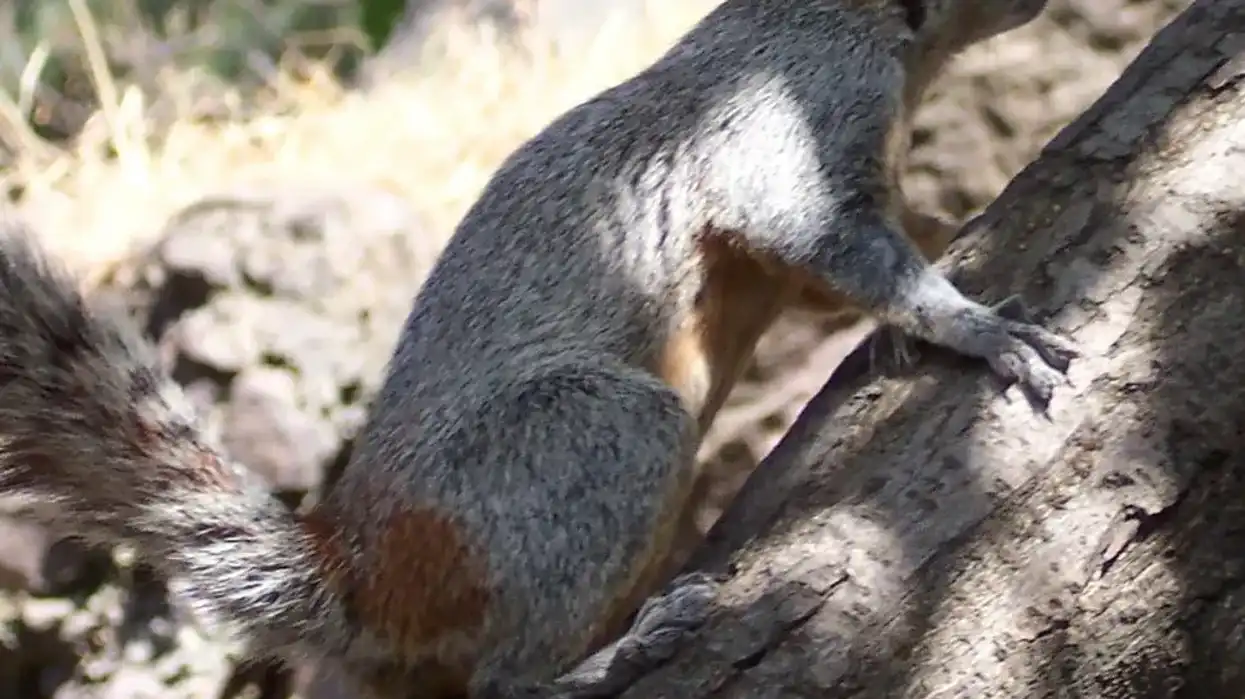The smallest squirrel in the world, possibly the most cutest rodent in the world, is found in central-western Africa. The name of this rodent is the African pygmy squirrel.
These tiny squirrels are arboreal by nature and are often seen frolicking in canopies in rainforests around various regions of Africa. These animals are native to Ethiopia.
The physical description of the African pygmy is very similar to that of other squirrels except for their size of course. The African pygmy squirrel is often seen playing on trees with other squirrels of their own kind.
They prefer to be 15 ft (5 m) above the ground and up high in trees. The African pygmy squirrel (Myosciurus pumilio) is diurnal, meaning that this squirrel is highly active during the day and at night they rest.
This species is solitary, however, they are sometimes seen hanging out with other fellow squirrels. An interesting skill that these rodents possess, and which only their species is able to do, is to move upside down and right side up as they move along the branches of their favorite hangout spots.
To know more about interesting creatures like this be sure to check out Indian palm squirrel facts or flying squirrel facts
African Pygmy Squirrel Interesting Facts
What type of animal is an African pygmy squirrel?
The African pygmy squirrel is an adorable rodent found in west-central Africa. They are diurnal and are seen foraging for food during the day. These animals are intelligent and share many characteristics with tree squirrels.
Their hind limbs are longer than their forelimbs and they have small bodies that help them move around swiftly on trees. Their bodies are bilaterally symmetrical. Their incisors grow throughout their lives.
There is a slight indication when it comes to the sex of African pygmy squirrels because female body size is moderately smaller compared to the males. The male cranial measurements are small in size. As these rodents are arboreal by nature, they are found in tropical rainforests.
What class of animal does an African pygmy squirrel belong to?
African pygmy squirrels are mammals and belong to the family of Sciuridae. Their scientific name is Myosciurus pumilio.
How many African pygmy squirrels are there in the world?
So far, little is known regarding the population of African pygmy squirrels.
Where does an African pygmy squirrel live?
The African pygmy squirrel distribution is seen in western central Africa including the countries of Cameroon, Gabon, northwestern Congo, and Equatorial Guinea as well the island of Bioko.
What is an African pygmy squirrel's habitat?
Found in their Ethiopian native habitat, African pygmy squirrels are mostly seen in tropical rainforests or canopies amongst tall trees. They are often busy foraging for food and playfully climbing up tree bark. Apart from that, you might see them sitting in their nest that is made from dried-up leaves.
Who do African pygmy squirrels live with?
African pygmy squirrels are solitary meaning they do not enjoy company and therefore are by themselves.
How long does an African pygmy squirrel live?
The African pygmy squirrel lifespan is not known due to a lack of information. Often squirrels live up to 9-15 years.
How do they reproduce?
There is limited information available regarding how African pygmy squirrels reproduce. It has been observed that they mature during a particular season. Like other squirrels, they are polygamous meaning they mate with more than one squirrel.
Often the male chases the female, and the most competitive male is selected. The female sexual reception lasts for only about a day.
Once the mating partner is selected, they mate in a secluded and safe place to ensure safety from predators. The female is said to bear two African pygmy squirrels. They are known to lactate however the weaning age of the little ones is not known.
Once the babies are born, the African pygmy squirrel takes utmost care of its newborn by protecting and nourishing them through lactation. As these squirrels are the smallest squirrel ever known, imagine how tiny their babies are!
What is their conservation status?
The population trend for the African pygmy squirrel is stable. The smallest squirrel can be found in abundance in canopies, playfully moving around. However, deforestation has been one of the major causes of their habitat loss. As of now, they are labeled as Least Concern however, in sanctuaries, care is being taken regarding their population.
African Pygmy Squirrel Fun Facts
What do African pygmy squirrels look like?
The African pygmy squirrel is a tiny rodent with an umber brown fur coat and a puffy tail. Their eyes have white borders. It is the smallest squirrel to exist on earth!
They are very similar to other tree squirrels. Their hind limbs are smaller than their forelimbs.
They have four incisor teeth that grow all their lives and help them eat food. Their appearance is endearing and makes one want to cuddle them however, they are always vigilant. Many people who come across this species love to watch them play in their natural habitat.

How do they communicate?
Squirrels are known to have their own unique language. African pygmy squirrels have keen hearing, eyesight and an excellent smelling sense.
Their communication and perception help them ensure their safety. They are vigilant and whenever they sense danger they tend to alarm fellow squirrels, their babies as well as other animals by giving out a faint pipping sound. They navigate their way on barks by using their vibrasse.
Vibrasse are like whiskers. It must be kept in mind that these animals are not social and are aloof most of the time.
How big is an African pygmy squirrel?
The African pygmy squirrel size is so small that a house rat is 10 times bigger in size. They weigh around 0.53–0.63 oz (15–18 g) and are lightweight.
Their body length is fairly small too ranging from 4.7–5.5 in (12–14 cm). Females are smaller in size compared to males but male cranial measurements are not as big as the females. These squirrels are just a little bigger than hamsters.
How fast can an African pygmy squirrel move?
These squirrels, like their relatives, are very fast at climbing up the bark of trees and foraging for food. Another special feature, apart from being the smallest squirrel in the world, is that they are the only species that can climb upside down and right side up while playing on trees.
The way they easily move on the underside of tree barks will blow your mind and make you question the concept of gravity!
How much does an African pygmy squirrel weigh?
African pygmy squirrel weight is lower compared to other species. This is mostly due to its body size. It is the smallest squirrel known, is extremely lightweight, and looks delicate. They weigh around 0.53–0.63 oz (15–18 g). Males tend to weigh more than females as they are larger in size.
What are the male and female names of the species?
The scientific name these squirrels share is Myosciurus pumilio. Often male squirrels are known as boars and female squirrels are called sows, however, there is no information regarding any names for this particular species.
What would you call a baby African pygmy squirrel?
Generally, a baby African pygmy squirrel is referred to as a kit or kitten but so far no specific name has been assigned to this species.
What do they eat?
These animals are omnivores and have a variety of foods they fancy. The African pygmy squirrel diet consists of insects, nuts, fruits, and seeds. They are also witnessed eating scraps of bark with their incisors. This way they consume the fungus present in bars. They eat ants and termites as well. However, unlike other squirrels, they don't store food.
Are they dangerous?
No, these adorable animals are not harmful at all. In fact, they are intimidated by humans.
Would they make a good pet?
These are adorable animals and people often want to adopt them. However, squirrels are wild animals and therefore cannot be domesticated. They are meant to enjoy their life in the wild! Many people try to domesticate them but it is not suitable for them. Many wildlife laws protect them, making it illegal to own a squirrel as a pet.
What are the different types of pygmy squirrels?
There is only one species of the pygmy squirrel from the family of Sciuridae. There are other species of squirrels existing such as the fox squirrels, antelope squirrels, and chipmunks.
What is the smallest species of squirrels called?
The smallest squirrel ever is called the African pygmy squirrel. They are smaller than a house mouse!
Here at Kidadl, we have carefully created lots of interesting family-friendly animal facts for everyone to discover! Learn more about some other mammals from our squirrel facts and Indian palm squirrel facts pages.
You can even occupy yourself at home by coloring in one of our free printable squirrel coloring pages.
* Please note that the main image is a least pygmy squirrel, not an African pygmy squirrel. If you have an image of an African pygmy squirrel, please let us know at hello@kidadl.com










